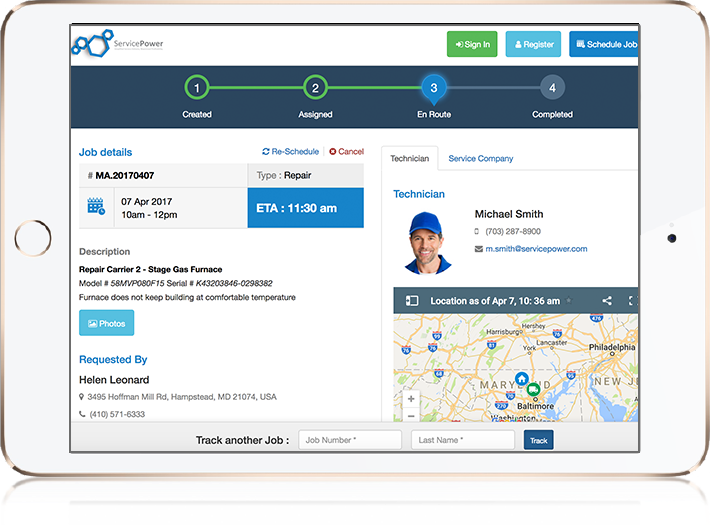Understanding Mobile Field Service Management
As the field service industry is shaped by new trends and technologies, it’s critical that field service organizations are attentive, agile, and...

It’s a familiar narrative: the pre-recorded call said the cable guy would come between 12 and three, but it’s now four o’clock, and there’s still no cable guy. You call your provider, and they apologize but don’t know the technician’s exact whereabouts since he doesn’t work directly for the organization. You try to haggle with them, ask for a supervisor, tell them you have dinner guests in an hour, but there’s nothing they can do. Finally, you give up and put dinner on the stove, which is precisely when the technician knocks on your door. He’s finally arrived but doesn’t have the right part in his van to make the fix, so he’ll have to come back a second, non-specific time. What does the visit cost? He isn’t sure. He doesn’t do the invoicing. It’ll show up on your next bill when he files the paperwork two weeks later, and by then you will have forgotten what it’s for, so you’ll have to call your provider yet again.
On the surface, this is a story about bad customer service. But at a functional level, it’s a perfect example of a field service technician trying to work without the right tools. Many organizations are already realizing the need to move from manual, paper-based workflows to field service management (FSM) software (only 22 percent of best-in-class companies still render field service from paper, and the software market itself is projected to reach $3.52 billion by 2019).
But it’s important to note that high-performance companies aren’t doing better because they buy the software. They’re doing better because the software helps them adopt a mobile-centric, real-time approach to field service management. Mobile FSM is one of the best ways a company can stay competitive and keep customers happy. This article will define the importance of mobile-friendly FSM software and outline ways your business can benefit.
As a strategic phrase, “mobile field service management” is a bit redundant. After all, you can’t manage field service unless you’re in the field, which requires you or your agents to be mobile. But when it comes to FSM systems, there are clear distinctions between mobile and nonmobile.
An older, on-premise system may offer centralization and reporting but usually requires agents to re-enter data from paper documents and invoices they completed in the field. Beyond a pager or personal cell phone, dispatchers likely have no way to communicate with an agent and vice versa.
Most modern FSMs, on the other hand, are cloud-based, which means technicians can access up-to-date information from mobile devices while on the job when they need them most. Many FSMs have native mobile apps for smartphones and tablets or can integrate with custom devices such as scanners, PDAs, and meter reading equipment. Certain vendors can even work with your company to develop a custom mobile solution that matches your technical workflow.
Some of the benefits of mobile FSM include optimized drive time, fewer repeat visits, and an increase in jobs completed per day. Mobile FSM adoption rates vary by industry. In Oil and Gas, for example, 75 percent of CIOs listed mobile technology as a high priority, and 55 percent said it would significantly improve their operations.
1. Access to service knowledge and back-end systems: We’ll assume your field service technicians are highly trained, but that doesn’t mean they don’t need tools. Mobile FSM apps give technicians access to resources and information that help them complete each job. For example, they can pull up manuals and schematics to determine the best repair procedures and which parts they’ll need. Some industry-specific mobile applications may also provide diagnostic tools such as Augmented Reality that further automate the troubleshooting process. Cloud-based repositories can contain asset history, warranty information, contracts, forms, parts, and inventory, as well as provide access to customer accounts for billing and invoicing functions.
2. Visibility and communication: It’s 10 am. Do you know where your technicians are? Better yet, can you reach them if you need to? If they’re still working from a clipboard, the answer is probably no, which is what you’ll have to tell customers. If they’re working from a mobile FSM system, your dispatchers will be able to see job progress and real-time location data, whether you work with in-house agents or third-party contractors. A mobile FSM also enables secure, bidirectional communication between the field and the main office or fleet hub. Technicians can share site information or questions with concerned parties to solve problems faster.
3. More accurate data entry and accounting: When field service agents have to scribble everything down by hand while they work, then key all the data in a second time back at the office, there’s a lot of room for error. Being able to record job details and new customer input directly onsite eliminates entry redundancies and saves labor hours. Some FSMs even offer integrated payment processing, which lets your agents collect payments or process refunds and obtain a digital signature for the completed work order. Where carbon copy receipts can get stomped into the bottom of the truck cab and smothered in moon pie wrappers, your digital records will be safe and secure in the cloud, leaving a clean trail for future audits. This also enables your field service company to start making data-driven decisions, which will ensure your success now and in the future.
4. Real-time routing and scheduling: On-the-job tools are essential to field service success, but it’s also important that agents have tools to get them to the job. Routing and scheduling features built into mobile FSMs help drivers organize their day based on pending work orders and plan an optimized route between all sites. Many apps even provide built-in mapping and geolocation. Technicians can log service hours, manage appointments, and view their schedules while still in the field, which reduces wait time windows and leaves room for more jobs per day.
Whether your company serves business clients, consumers, or other community stakeholders, there’s a strong correlation between efficient field service and customer satisfaction. Your technicians and contractors are on the front lines, often in people’s homes. That means they are ambassadors for your brand in a very tangible way.
The service industry has set the bar high. According to Aberdeen Group, “best-in-class” field service professionals have an 89 percent first-time fix rate and 92 percent compliance with stated response times.
Getting the job done right means getting it done on time the first time and avoiding careless logistical complications. In order to accomplish this, organizations should take a holistic approach—give their agents clear directives, an open line of communication, and support workflows with the right technology.
Explore how ServicePower can empower your company with a best-in-class mobile FSM solution that maximizes time to ROI. Learn more.

As the field service industry is shaped by new trends and technologies, it’s critical that field service organizations are attentive, agile, and...

The demand for mobile field service management has grown dramatically with the rise of the digital transformation in the field service industry, and...

When your business model, backed by your current stack of enterprise workforce management software, has been working well, it's hard to see a reason...